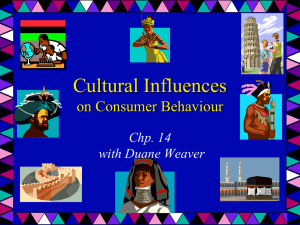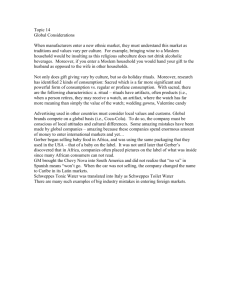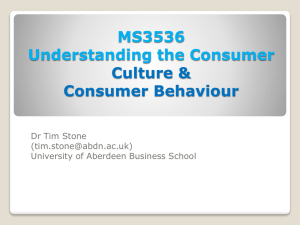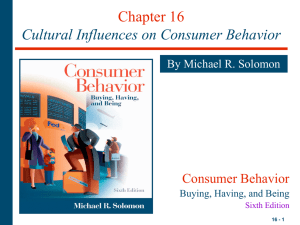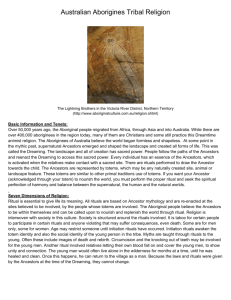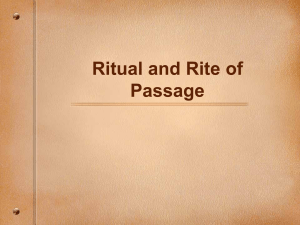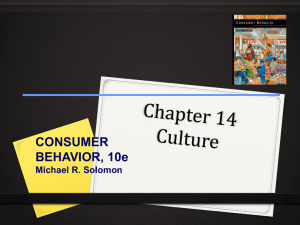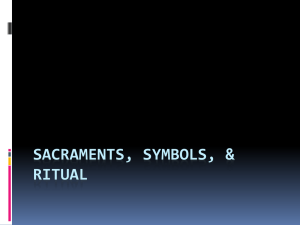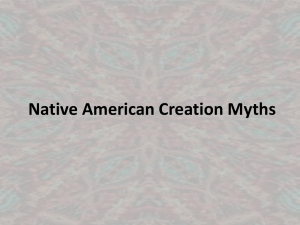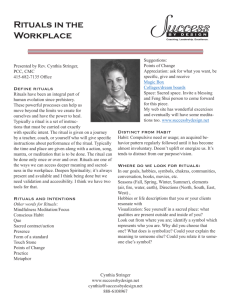Group 4 Cultural Influences
advertisement
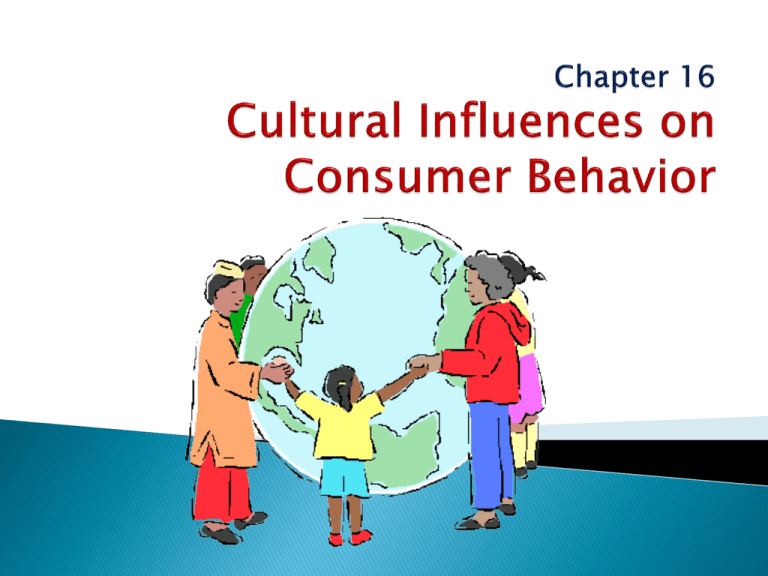
At the end of this chapter you should understand: What is culture? What are cultural dimensions? Myths and assumptions Rituals (gift-giving, holiday) Rites of passage Sacred and profane Consumption (sacred places, sacred people, sacred events) Culture is the accumulation of shared meaning, rituals, norms and traditions among the members of an organization/society Culture is a society’s personality Our culture determine the overall priorities we attach to different activities and products Products can reflect underlying cultural processes of a particular period: Examples: Gablinger’s low-cal beer introduced in the 1960’s failed Cosmetics made from natural material without animal testing-pollution, waste and animal rights Ecology Social structure Ideology Ecology: the way a system adapt to its habitat, resources shape its ecology. Example: Japanese greatly value products that make efficient use of space because of the cramped conditions in their urban centers Social Structure: the way people maintain an orderly social life-product purchase also depend on ur social structure. Example: representative govt. (democracy) vs. dictatorship Ideology: the way people relate to their environment and social groups Examples: Water Kingdom in Bombay (Theme park), consumers are unaware with mixed-sex swimming in public- the swim suits cover the women from wrists to ankles Power Distance Way members perceive differences in power when they form interpersonal relationships Uncertainty Avoidance Degree to which people feel threatened by ambiguous/ unknown situations Masculine versus Feminine Degree to which social and gender roles are clearly delineated Individualism versus Collectivism Extent to which culture values the welfare of the individual versus that of the group Enacted norms are specifically chosen Crescive norms are discovered as we interact with others ◦ Customs: norms handed down from the past that control basic behavior ◦ Mores: custom with a strong moral overtone ◦ Conventions: norms regarding the conduct of everyday life Every culture develops stories and ceremonies that help members make sense of the world ◦ Lucky rabbit’s foot ◦ Lucky numbers (e.g., number 8 in China) ◦ Magic remedies (computers)-simplify our “lives” by providing easy answers ◦ Evil eye, stone rings (amulets to ward off badluck) ◦ Lottery Myths are stories with symbolic elements that represent the shared emotions/ideals of a culture Myths are culturecentric so they take on different forms around the world Story characteristics ◦ Conflict between opposing forces ◦ Outcome is moral guide for people ◦ Myth reduces anxiety by providing guidelines to the consumers Myths are often found in comic books, movies, holidays, and commercials Monomyths: a myth that is common to many cultures (e.g., Spiderman and Superman) Many movies/commercials present characters and plot structures that follow mythic patterns ◦ Gone With the Wind ◦ E.T.: The Extraterrestrial ◦ X-Men Eggs are bad for your heart Carbohydrates make you fat Calories eaten at night are more fattening than those eaten early in the day Radiation in microwaves create dangerous compounds in your food Microwaving zaps nutrients You crave certain foods because you’re deficient in one of the nutrients they provide Its important to fast periodically, to cleanse toxins from your body What are Rituals? Multiple, symbolic behaviors/ series of acts performed in a same way. We perform Rituals according to our cultural and religious values for example; wedding ceremonies. This refers to all those specialty products that are used and consumed in various religious and social rituals Ritual artifacts Ritual scripts Ritual script guides the use of various artifactual materials. Muslim wedding rituals. Consumers buy products according to their rituals for example particular wedding consumptions. Businesses supply ritual artifacts (Items needed to perform rituals) to consumers for example wedding rice, birthday candles etc. Grooming Rituals All consumers have private grooming rituals. They aid in transition from private to public self. A women believes in going to parlor before going to a social gathering, if she won’t visit a parlor she wouldn’t be able to move confidently in the gathering. Men shaving before going out is another example of grooming rituals Private/public and work/leisure personal rituals Beauty rituals reflect transformation from natural state to social world or vice versa Consumers try to procure a perfect object to gift someone and before giving it they remove the price tag and carefully wrap it. Gift-giving is form of; Economic exchange Symbolic Exchange Social Expression Gestation: Giver is motivated by an event to procure a gift. Structural event: prescribed by culture (e.g; Basant) Emergent event: more personal. Presentation: process of gift exchange when recipient responds to a gift and donor evaluates the response. Reformulation: Giver and receiver adjust the bond between them Holidays are based on a myth with a character at center of story Marketers find ways to encourage gift giving and provide artifacts to perform those rituals Businesses invent new occasions to raise on need for cards/ritual artifacts Mother’s day, Grandparents’ Day etc Retailers elevate minor holidays to major ones to provide merchandising opportunities Definition: A rite of passage is a ceremony and marks the transition from one phase of life to another. & A rite of passage is a ritual event that marks a person's transition from one status to another. It can be Natural (Death, Puberty) Individuals (Getting divorced) •Separation •Liminality •Aggregation Sacred: It involves objects and events that are set apart from normal activities that are treated with respect. Profane: It describes the objects and events that are ordinary. Sacred places: Sacred people: Sacred events: Local products Pictorial images ‘Piece of the rock Literal representations Markers Definition: Sacralization occurs when ordinary objects, events, and even people take on sacred meaning Desacralization: when a sacred item/symbol is removed from its special place or is duplicated in mass quantities (becomes profane).
